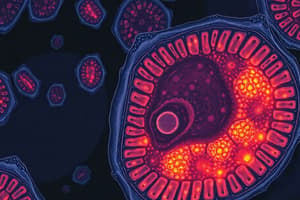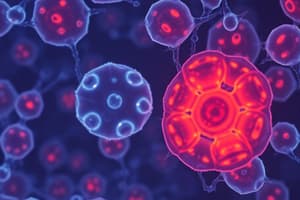Podcast
Questions and Answers
What is the role of the nucleus in a eukaryotic cell?
What is the role of the nucleus in a eukaryotic cell?
The nucleus is the control center of the cell, containing most of the cell's DNA, which carries the genetic instructions for the cell's activities.
Explain the relationship between DNA, mRNA, and ribosomes in protein synthesis.
Explain the relationship between DNA, mRNA, and ribosomes in protein synthesis.
DNA serves as a template for the production of mRNA. The mRNA then travels to the ribosomes, where it carries the genetic code for building proteins.
What is the function of the rough endoplasmic reticulum (ER) in protein synthesis?
What is the function of the rough endoplasmic reticulum (ER) in protein synthesis?
The rough ER is studded with ribosomes, which synthesize proteins. The rough ER folds and modifies these proteins before sending them to their destinations within the cell or outside the cell.
What are some of the differences between plant and animal cells?
What are some of the differences between plant and animal cells?
Describe the role of the cytoskeleton in a cell.
Describe the role of the cytoskeleton in a cell.
What is the purpose of the 'Abstract' section in a lab report?
What is the purpose of the 'Abstract' section in a lab report?
What is the primary purpose of the 'Introduction' section in a lab report?
What is the primary purpose of the 'Introduction' section in a lab report?
Why should the 'Materials and Methods' section be simplified in a lab report?
Why should the 'Materials and Methods' section be simplified in a lab report?
What is the purpose of the 'Results' section in a lab report?
What is the purpose of the 'Results' section in a lab report?
How many figures should be included in a lab report's 'Results' section?
How many figures should be included in a lab report's 'Results' section?
How should the 'Results' section be structured?
How should the 'Results' section be structured?
Why is it important to include visuals, like figures, in the 'Results' section?
Why is it important to include visuals, like figures, in the 'Results' section?
Aside from the sections mentioned, what other essential components are typically included in a lab report?
Aside from the sections mentioned, what other essential components are typically included in a lab report?
What is the reason why most cells are invisible to the naked eye?
What is the reason why most cells are invisible to the naked eye?
Describe the primary function of a microscope in cell biology.
Describe the primary function of a microscope in cell biology.
Explain the basic principle behind how a light microscope (LM) creates an image.
Explain the basic principle behind how a light microscope (LM) creates an image.
How does the use of microscopes contribute to our understanding of cell structure and function?
How does the use of microscopes contribute to our understanding of cell structure and function?
Besides microscopy, what other tools are used in the study of cells? Briefly describe how one of these tools is used to study cells.
Besides microscopy, what other tools are used in the study of cells? Briefly describe how one of these tools is used to study cells.
What is the primary purpose of cell fractionation?
What is the primary purpose of cell fractionation?
How does centrifugation work in cell fractionation?
How does centrifugation work in cell fractionation?
What is the significance of the homogenization step in cell fractionation?
What is the significance of the homogenization step in cell fractionation?
What can scientists determine by using cell fractionation techniques?
What can scientists determine by using cell fractionation techniques?
Why is differential centrifugation used in cell fractionation?
Why is differential centrifugation used in cell fractionation?
What is the main difference in DNA arrangement between prokaryotic and eukaryotic cells?
What is the main difference in DNA arrangement between prokaryotic and eukaryotic cells?
How does cell division differ between prokaryotic and eukaryotic organisms?
How does cell division differ between prokaryotic and eukaryotic organisms?
Name two organelles that are present in eukaryotic cells but absent in prokaryotic cells.
Name two organelles that are present in eukaryotic cells but absent in prokaryotic cells.
What steps does insulin mRNA go through after it is released from the nucleus?
What steps does insulin mRNA go through after it is released from the nucleus?
What is the reproductive method of prokaryotic organisms?
What is the reproductive method of prokaryotic organisms?
What is the primary function of ribosomes in a cell?
What is the primary function of ribosomes in a cell?
Describe the structure and function of the nuclear envelope.
Describe the structure and function of the nuclear envelope.
What role do pore complexes play in the nucleus?
What role do pore complexes play in the nucleus?
What are chromosomes and how are they related to DNA?
What are chromosomes and how are they related to DNA?
What is the function of the nucleolus within the nucleus?
What is the function of the nucleolus within the nucleus?
What distinguishes free ribosomes from bound ribosomes?
What distinguishes free ribosomes from bound ribosomes?
What components make up the endomembrane system?
What components make up the endomembrane system?
What are the two distinct regions of the endoplasmic reticulum?
What are the two distinct regions of the endoplasmic reticulum?
List four functions of the Smooth ER.
List four functions of the Smooth ER.
What is the primary function of the Rough ER?
What is the primary function of the Rough ER?
What is the role of the Golgi apparatus in a cell?
What is the role of the Golgi apparatus in a cell?
How are lysosomal enzymes produced and processed?
How are lysosomal enzymes produced and processed?
Explain the process of phagocytosis.
Explain the process of phagocytosis.
Flashcards
Figure Legend
Figure Legend
A brief paragraph describing a figure in a report.
Eukaryotic Cell
Eukaryotic Cell
Cells that have internal membranes and a nucleus.
Endomembrane System
Endomembrane System
A system in eukaryotic cells that regulates protein traffic and metabolic functions.
Mitochondria
Mitochondria
Signup and view all the flashcards
Light Microscope (LM)
Light Microscope (LM)
Signup and view all the flashcards
Lab Report Title
Lab Report Title
Signup and view all the flashcards
Abstract
Abstract
Signup and view all the flashcards
Introduction
Introduction
Signup and view all the flashcards
Materials and Methods
Materials and Methods
Signup and view all the flashcards
Results Section
Results Section
Signup and view all the flashcards
Experiments' Purpose
Experiments' Purpose
Signup and view all the flashcards
Figures in Results
Figures in Results
Signup and view all the flashcards
Organization of Results
Organization of Results
Signup and view all the flashcards
Cell Fractionation
Cell Fractionation
Signup and view all the flashcards
Centrifuge
Centrifuge
Signup and view all the flashcards
Homogenization
Homogenization
Signup and view all the flashcards
Differential Centrifugation
Differential Centrifugation
Signup and view all the flashcards
Supernatant
Supernatant
Signup and view all the flashcards
Nucleus
Nucleus
Signup and view all the flashcards
RNA transcription
RNA transcription
Signup and view all the flashcards
Chromatin
Chromatin
Signup and view all the flashcards
Ribosomes
Ribosomes
Signup and view all the flashcards
Nucleolus
Nucleolus
Signup and view all the flashcards
Prokaryotic Cells
Prokaryotic Cells
Signup and view all the flashcards
DNA Arrangement in Prokaryotes
DNA Arrangement in Prokaryotes
Signup and view all the flashcards
Mitosis vs Binary Fission
Mitosis vs Binary Fission
Signup and view all the flashcards
Ribosome Size Comparison
Ribosome Size Comparison
Signup and view all the flashcards
Insulin Protein Production Steps
Insulin Protein Production Steps
Signup and view all the flashcards
Nuclear Envelope
Nuclear Envelope
Signup and view all the flashcards
Pore Complex
Pore Complex
Signup and view all the flashcards
Chromosomes
Chromosomes
Signup and view all the flashcards
Smooth ER
Smooth ER
Signup and view all the flashcards
Rough ER
Rough ER
Signup and view all the flashcards
Golgi Apparatus
Golgi Apparatus
Signup and view all the flashcards
Lysosomes
Lysosomes
Signup and view all the flashcards
Hydrolytic Enzymes
Hydrolytic Enzymes
Signup and view all the flashcards
Vesicles
Vesicles
Signup and view all the flashcards
Phagocytosis
Phagocytosis
Signup and view all the flashcards
Study Notes
Cell Structure and Function
- Biologists use microscopes and biochemistry to study cells
- Cells are too small to be seen with the naked eye
- Microscopes are used to visualize cells
- Light microscopes (LM) use a series of glass lenses to magnify images by focusing light through an object
- Electron microscopes (EM) are used to study subcellular structures
- Scanning electron microscopes (SEM) study the outside surface of structures
- Transmission electron microscopes (TEM) study the internal structure of cells
Cell Fractionation
- Cell fractionation separates major organelles from one another
- Centrifuges fractionate cells into their component parts based on density
- This helps scientists determine organelle functions
Eukaryotic Cells
- Eukaryotic cells contain internal membranes that compartmentalize functions
- Prokaryotic cells are only found in the Bacteria and Archaea domains
- Eukaryotic cells are found in protists, fungi, animals and plants
- Eukaryotic cells have internal membranes that divide the cell into compartments, known as organelles
- The basic fabric of biological membranes is a double layer of phospholipids and other lipids
- Plant and animal cells share many of the same organelles
The Nucleus
- The nucleus contains most of the cell's genetic material (DNA) and is visible under a light microscope.
- The nuclear envelope encloses the nucleus and separates it from the cytoplasm, composed of two lipid bilayers
- The nuclear envelope has pores lined with a pore complex, which regulates molecule entry and exit from the nucleus
- The nuclear size and shape are maintained by the nuclear lamina, a network of proteins
- DNA within nucleus is organized into chromosomes; condensed chromatin
- The nucleolus is within the nucleus and synthesizes ribosomal RNA (rRNA)
Ribosomes
- Ribosomes are complexes made of ribosomal RNA and protein
- They carry out protein synthesis
- Ribosomes can be free in the cytosol or bound to the endoplasmic reticulum or the nuclear envelope
The Endomembrane System of a Eukaryotic Cell
- The endomembrane system consists of the nuclear envelope, endoplasmic reticulum(ER), Golgi apparatus, lysosomes, vacuoles, and the plasma membrane; they are either continuous or connected via vesicles
- Rough ER has ribosomes on the surface and synthesizes glycoproteins, lipids
- Smooth ER lacks ribosomes and synthesizes lipids, metabolizes carbohydrates, detoxifies drugs and poisons, and stores calcium
- Golgi apparatus modifies ER products, manufactures some macromolecules, sorts packages materials into transport vesicles
- Lysosomes are sacs of hydrolytic enzymes that digest macromolecules
- Phagosytosis is the process by which a cell engulfs large materials
- Autophagy is the process in which lysosomes recycle the cell's own organelles and macromolecules
- Peroxisomes contain enzymes that transfer hydrogen from compounds to oxygen, producing hydrogen peroxide (H2O2) which converts to water; involved in detoxification of oxidative stress
Vacuoles
- Vacuoles are large vesicles with diverse functions.
- Contractile vacuoles are in freshwater protists and pump out excess water;
- Central vacuoles are in many plant cells that hold organic compounds and water
Mitochondria and Chloroplasts
- Mitochondria are the sites of cellular respiration and generate ATP
- Chloroplasts, in plants and algae, are the sites of photosynthesis
- Both have their own DNA and ribosomes and resemble bacteria, thought to have originated via endosymbiosis.
Organelle Structure
- Detailed descriptions of the structures of mitochondria and chloroplasts, emphasizing their internal membranes and compartments, are provided in the text.
Prokaryotes vs Eukaryotes
- Differences in structure and function between prokaryotic and eukaryotic cells are highlighted, including cell size, wall structure and organelle type.
Insulin
- Insulin is a hormonal protein that's secreted by the pancreas when glucose in the blood is high, to lower blood sugar.
- Steps in synthesis and secretion of insulin from DNA to blood vessels, briefly explained.
Studying That Suits You
Use AI to generate personalized quizzes and flashcards to suit your learning preferences.




